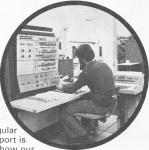and this isn’t it.

Me re-booting an IBM System 360/40 in 1975
When I first started in IT in 1974 or as it was called back then, data processing, open source was the only thing. People were already depending on it, and defending their right to access source code.
I’m delighted with the number and breadth of formal organizations that have grown-up around “open source”. They are a great thing. Strength comes in numbers, as does recognition and bargaining power. Congratulations to the Open Source Initiative and everything they’ve achieved in their 20-years.
I understand the difference between closed source, (restrictive) licensed source code, free source, open source etc. The point here isn’t to argue one over the other, but to merely illustrate the lineage that has led to where we are today.
Perhaps one of the more significant steps in the modern open source movement was the creation in 2000 of the Open Source Development Labs, (OSDL) which in 2007 merged with the Free Standards Group (FSG) to become the Linux Foundation. But of course source code didn’t start there.
Some people feel that the source code fissure was opened when Linus Torvalds released his Linux operating system in 1991 as open source; while Linus and many others think the work by Richard Stallman on the GNU Toolset and GNU License started in 1983, was the first step. Stallman’s determined advocacy for source code rights and source access certainly was a big contributor to where open source is today.
But it started way before Stallman. Open source can not only trace its roots to two of the industries behemoths, IBM and AT&T, but the original advocacy came from them too. Back in the early 1960’s, open source was the only thing. There wasn’t a software industry per se until the US Government invoked its’ antitrust law against IBM and AT&T, eventually forcing them, among other things, to unbundle their software and make it separately available as well as many other related conditions.
’69 is the beginning, not the end
The U.S. vs.I.B.M. antitrust case started in 1969, with trial commencing in 1975(1). The case was specifically about IBM blocking competitive hardware makers getting access and customers being able to run competitive systems, primarily S/360 architecture, using IBM Software.
In the years leading up to 1969, customers had become increasingly frustrated, and angry at IBM’s policy to tie it’s software to its hardware. Since all the software at that time was source code available, what that really meant was a business HAD to have one IBM computer to get the source code, it could then purchase an IBM plug-compatible manufacturers (PCM) computer(2) and compile the source code with the manufacturers Assembler and tools, then run the binaries on the PCM systems.
IBM made this increasingly harder as the PCM systems became more competitive. Often large previously IBM only systems users who would have, 2, 4, sometimes even 6 IBM S/360 systems, costing tens of millions of dollars, would buy a single PCM computer. The IBM on-site systems engineers (SE) could see the struggles of the customer, and along with the customers themselves, started to push back against the policy. The SE job was made harder the more their hands were tied, and the more restrictions that were put on the source code.
To SHARE or not to?
For the customers in the US, one of their major user groups, SHARE had
a vast experience in source code distribution, it’s user created content, tools tapes were legend, what most never knew, is that back in 1959, with General Motors, SHARE had its own IBM mainframe (709) operating system, the SHARE Operating System (SOS).
At that time there was formal support offerings of on-site SE’s that would work on problems and defects in SOS. But by 1962, IBM had introduced it’s own S/7090 Operating System, which was both incompatible with SOS, and also at that time IBM withdrew support by it’s SE and Program Support Representatives (PSR’s) to work on SOS.
1965 is where to the best of my knowledge is when the open source code movement, as we know it today, started
To my knowledge, that’s where the open source code movement, as we know it today, started. Stallman’s experience with a printer driver mirrors exactly what had happened some 20-years before. The removal of source code, the inability to build working modifications to support a business initiative, using hardware and software ostentatiously already owned by the customer.
IBM made it increasingly harder to get the source code, until the antitrust case. By that time, many of IBMs customers had created and depended on small, and large modifications to IBM source code.
Antitrust outcomes
 By the mid-70’s, once of the results of years of litigation, and consent decrees in the United States, IBM had been required to unbundle its software, and make it available separately. Initially it was chargeable to customers who wanted to run it on PCM, non-IBM systems, but overtime as new releases and new function appeared, even customers with IBM systems saw a charge appear, especially as Field Developed Programs, moved to full Program Products and so on. In a bid to stop competing products, and user group offerings being developed from their products, this meant the IBM Products were increasingly supplied object-code-only (OCO). This became a a formal policy in 1983.
By the mid-70’s, once of the results of years of litigation, and consent decrees in the United States, IBM had been required to unbundle its software, and make it available separately. Initially it was chargeable to customers who wanted to run it on PCM, non-IBM systems, but overtime as new releases and new function appeared, even customers with IBM systems saw a charge appear, especially as Field Developed Programs, moved to full Program Products and so on. In a bid to stop competing products, and user group offerings being developed from their products, this meant the IBM Products were increasingly supplied object-code-only (OCO). This became a a formal policy in 1983.
I’ve kept the press cutting from ComputerWorld(March 1985) shown above since my days at Chemical Bank in New York. It pretty much sums-up what was going on at the time, OCO and users and user groups fighting back against IBM.
What this also did is it gave life to the formal software market, companies were now used to paying for their software, we’ve never looked back. In the time since those days, software with source code available has continued to flourish. With each new twist and evolution of technology, open source thrives, finds it’s own place, sometimes a dominant position, sometimes subservient, in the background.
The times in the late 1950’s and 60’s were the dawn of open source. If users, programmers, researchers and scientists had not fought for their rights then, it is hard to know where the software industry would be now.
(1) The PCM industry had itself come about as a result of a 1956 antitrust case and the consent decree that followed.
(2) The 1969 antitrust case was eventually abandoned in 1982.
![msdos-logo-150x150[1]](https://cathcam.files.wordpress.com/2018/10/msdos-logo-150x1501.png?w=500) Interestingly, Microsoft have announced they are re-open sourcing the code for MS-DOS 1.25 and 2.0 releases. Although never available outside of Microsoft or IBM in its entirety, there were certainly sections o the code floating around in the mid-1980’s. I was given the code for some drivers in 1984 by an IBM Systems Engineer, which I proceeded to hack and use as a starter for the 3270 driver I used for file transfer.
Interestingly, Microsoft have announced they are re-open sourcing the code for MS-DOS 1.25 and 2.0 releases. Although never available outside of Microsoft or IBM in its entirety, there were certainly sections o the code floating around in the mid-1980’s. I was given the code for some drivers in 1984 by an IBM Systems Engineer, which I proceeded to hack and use as a starter for the 3270 driver I used for file transfer.


 Colleague Randy Guck, who leads our open source Doradus project, recent gave an O’Reilly Webcast on the project and using Doradus to extend Cassandra for high performance analytics.
Colleague Randy Guck, who leads our open source Doradus project, recent gave an O’Reilly Webcast on the project and using Doradus to extend Cassandra for high performance analytics.


Recent Comments